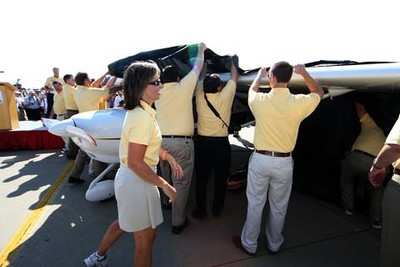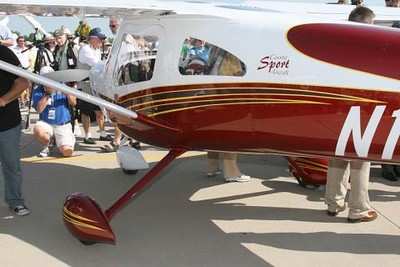Unveiling Is A Hit; Will This Plane Be Built?
"It's beautiful!"
"It's like a 150 -- no, it's not. Look where the struts
attach, behind the doors!"
"The doors open up."
"It's a fastback like a 1950s 172 -- back to the
future!"
"It really is beautiful."

Cessna President and CEO Jack Pelton beamed from the podium as
the audience reacted to the latest Cessna rollout. The introduction
was as choreographed as a Thunderbirds performance or a display of
the Marine Corps Precision Drill Team -- or a Citation introduction
-- but this time it's wasn't a multi-million-dollar jet.
The recently-announced interest of Cessna in the Light Sport
Aircraft market has borne its first fruit in the form of the Proof
of Concept aircraft shown to the public today. Judging from the
reaction, it's a hit. Cessna will be looking for feedback -- they
are collecting surveys from pilots and pilot wannabees at the show
this week, and Cessna marketeers will pore over the data, trying to
discern the future direction of the company -- and possibly, a
large part of the market.

The weather was perfect for the introduction. Oshkosh's
blowtorch summer weather has abated just enough to make it a lovely
morning with a fresh breeze, suggestive of outdoor pursuits. You
know, like flying. The POC aircraft rested under a black, billowing
cloth, under the exact sort of sky that its progeny might one day
launch into, bearing thousands of new pilots on airborne
adventures.

The cloth was held in place by grinning Cessna employees in
yellow Cessna Sport shirts, Pelton stressed that the airplane that
we saw was not necessarily going to be produced in this exact
format -- or even at all. But he personally is clearly excited
about Sport Pilot and the Light Sport Aircraft, which he described
as key to "stimulate feeding the important pipeline of human
talent," the future pilots that are the future aviators of the
world.

Underlying Cessna's logic is a marketing fact; the pilot that
learns in a Cessna aircraft often retains a career-long partiality
to Cessna airplanes, even when he or she reaches career pinnacles
that may include flying jets, running operations that fly jets, or
-- significantly -- buying jets for others to fly. That model is
never far from the mind of Jack Pelton, who told Aero-News in a
two-part interview in 2004 of his early days learning to fly (in,
appropriately enough, a Cessna 140) and the pleasure he still finds
in flying light aircraft.
An overview: The aircraft is a conventional high-wing monoplane
with a conventional swept tail, straight wings with flaps and
ailerons each of about half-span, and tricycle landing gear with a
castering nosewheel. The main landing gear resemble those of the
152 at a glance, and may be a similar steel-strut in alloy fairing
arrangement. It's powered by the Rotax 912S four-cylinder
four-stroke motor.
The struts join the fuselage at the same station as the main
landing gear, behind the doors, which open up in a gull-wing
arrangement.

It has a "fastback" design like the first 150s and 172s; the
back windows of mid-1960s-up Cessnas lead to a light, airy cabin
but create significant drag; air running along a surface doesn't
like having that surface yanked away. This helps the plane make
speed; while Pelton said it was too early to expect specifications
or performance numbers, he did promise that the plane would come in
at the LSA gross weight of 1320 lb, and meet the maximum LSA
permissible speed of 120 kt. (The fastback design also appears on
the Next Generation Prototype, another (surprise!) plane briefly
shown at this introduction -- see the other story).
The wingspan is 30 feet, about 10% less than that of the Cessna
152 (33'4") and the chord seems less. The height of the aircraft
overall and of the wings seems less (a tall man can check the fuel
level with his feet on the ground), and the cabin is significantly
wider than even the 172's at 40 inches.
The plane is pretty, small, and clearly designed for rapid,
low-cost manufacturing. It is in a way a compendium of best
practices in high-wing SLSA design, comprised mostly aluminum
alloy.
One of the things that we thought might be significant about the
airplane was the N Number: N158CS. "CS" is Cessna Sport, of course,
but is this plane potentially the Cessna 158? Your guess is as good
as ours; Cessna isn't saying.
How much? Cessna isn't saying that either. "It will be priced
competitively with similar LSAs," is what Jack Pelton says. What
that means in dollars and cents, it's too early to know.

Cessna's planes are popular enough; they expect to manufacture
as many as 900 new single-engine aircraft this year. But the
company isn't going to rest on its laurels in the single-engine
line any more than it does in its jet line, where it keeps up a
feverish pace of product introductions and upgrades.
Cessna doesn't need a SLSA. That's one way of looking at it.
But Cessna does need an SLSA, Pelton seems to think, despite his
cautious verbiage. He is not thinking about this year, an expected
banner year for Cessna single-engine production; he's looking
decades ahead. But it's fair to close on his note of caution.
"We're not going to build this, unless we have a high level of
confidence we can meet expectations for quality and performance,"
he told the throng. From the oohs and ahhs that greeted the
unveiling of the red and white Proof of Concept, they're well on
the way.
 ANN's Daily Aero-Linx (04.16.24)
ANN's Daily Aero-Linx (04.16.24) Aero-News: Quote of the Day (04.16.24)
Aero-News: Quote of the Day (04.16.24) Airborne 04.10.24: SnF24!, A50 Heritage Reveal, HeliCycle!, Montaer MC-01
Airborne 04.10.24: SnF24!, A50 Heritage Reveal, HeliCycle!, Montaer MC-01 Airborne 04.12.24: SnF24!, G100UL Is Here, Holy Micro, Plane Tags
Airborne 04.12.24: SnF24!, G100UL Is Here, Holy Micro, Plane Tags Airborne-Flight Training 04.17.24: Feds Need Controllers, Spirit Delay, Redbird
Airborne-Flight Training 04.17.24: Feds Need Controllers, Spirit Delay, Redbird








